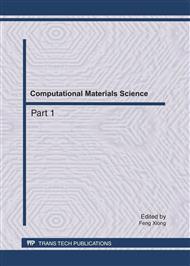[1]
SUN Kai, PAN Jia-hu. New technology for drug discovery[J]. Chin J New Drugs Clin Rem, 2007, 26(10): 783-787.
Google Scholar
[2]
Houston JB, Carlile DJ. Prediction of hepatic clearance from microsomes, hepatocytes, and liver slices [J]. DrugMetab Rev, 1997, 29: 891-922.
DOI: 10.3109/03602539709002237
Google Scholar
[3]
Houston BJ. Utility of in vitro drug metabolism data in prediction in vivo metabolic clearance [J]. Biochem Pharm, 1994, 47: 1469-1479.
DOI: 10.1016/0006-2952(94)90520-7
Google Scholar
[4]
MohutskyMA, Chien JY, et al. Predictions of the in vivo clearance of drugs from rate of loss using human liver microsomes for phase I and phase II biotransformations [J]. Pharm Res, 2006, 23: 654-662.
DOI: 10.1007/s11095-006-9663-4
Google Scholar
[5]
Obach SR, Baxter JG, L iston TE, et al. The p rediction of human pharmacokinetic parameters from p reclinical and in vitro metabolism data [J]. J Pharmacol Exp Ther, 1997, 283: 46 – 58.
Google Scholar
[6]
R. Scott Obach. Prediction of human clearance of twenty-nine drugs from hepatic microsomal intrinsic clearance data [J]. The American Society for Pharmacology and Experimental Therapeutics, 1999, 27(11): 1350 - 1359.
Google Scholar
[7]
Thomas Fox , Jan M. Kriegl. Machine Learning Techniques for In Silico Modeling of Drug Metabolism. Current Topics in Medicinal Chemistry, 2006, 6: 1579-1591.
DOI: 10.2174/156802606778108915
Google Scholar
[8]
Gisbert Schneider, * Philippe Coassolo, Thierry Lavé. Combining in Vitro and in Vivo Pharmacokinetic Data for Prediction of Hepatic Drug Clearance in Humans by Artificial Neural Networks and Multivariate Statistical Techniques.J. Med. Chem. 1999, 42: 5072-5076.
DOI: 10.1021/jm991030j
Google Scholar
[9]
Jochen Zuegge, Gisbert Schneider, et al. Prediction of Hepatic Metabolic Clearance: Comparison and Assessment of Prediction Models. Clin. Pharmacokinet. 2001, 40(7), 553-563.
DOI: 10.2165/00003088-200140070-00006
Google Scholar
[10]
XU Li, JIANG Jiang-ping. CMAC Neural Network Based Learning Control of the CSTR System, Control and Decision, 1992, Vol. 7, No. 2, 131-136.
DOI: 10.1109/sicici.1992.637733
Google Scholar
[11]
Shun F S, Ted T, Hung T H.: Credit assigned CMAC and its application to online learning robust controllers. IEEE Trans on Systems, Man, and Cybernetics-part B: Cybernetics, 2003, 33 (2), p.202-2l3 (2003).
DOI: 10.1109/tsmcb.2003.810447
Google Scholar
[12]
Zhu Da-qi, Zhang Wei.: Nonlinear identification algorithm of the improved CMAC based on balanced learning. Proc. Control and Decision, 2004, 19 (12), pp.1425-1428 (2004).
Google Scholar
[13]
Yingqi Ge, Xiaoping Luo, Pengying Du.: A New Improved CMAC Neural Network. Proc. CCDC 2010, pp.3271-3274.
DOI: 10.1109/ccdc.2010.5498618
Google Scholar


